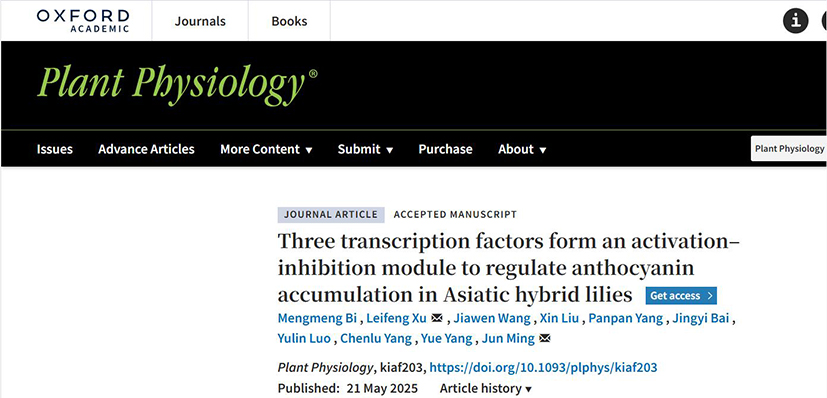Recently, the Lily Breeding Team at the Institute of Vegetables and Flowers, Chinese Academy of Agricultural Sciences, uncovered the molecular regulatory mechanism of the LhHB4-LhWRKY44-LhMYBSPLATTER module in controlling anthocyanin synthesis in lilies. The study, titled "Three transcription factors form an activation–inhibition module to regulate anthocyanin accumulation in Asiatic hybrid lilies," was published in the prestigious international journal Plant Physiology.

Flower color is a key ornamental trait that significantly influences the commercial value of ornamental plants. Anthocyanins are the primary pigments responsible for pink, red, purple, and purple-black flower colors. The accumulation of anthocyanins in different regions of lily tepals forms various color patterns, such as splattered spots, raised spots, brush-like streaks, bicolors, and multicolors. Therefore, elucidating the mechanisms underlying the formation of different flower colors and patterns holds great theoretical significance for the regulation of lily flower color and molecular breeding.
In recent years, the research team has focused on studying the molecular mechanisms of bicolor lily formation. Previous research identified that the WRKY family transcription factor LhWRKY44 positively regulates anthocyanin synthesis in lilies. LhWRKY44 activates the expression of the R2R3-MYB transcription factor LhMYBSPLATTER, which then forms an activating MBW complex with LhbHLH2 to promote the expression of structural genes involved in anthocyanin synthesis, ultimately enhancing anthocyanin production (Horticulture Research, 2023). In this study, the team identified an HD-Zip transcription factor, LhHB4, containing a typical EAR repression motif. This transcription factor directly binds to the promoters of LhWRKY44 and LhMYBSPLATTER, inhibiting their expression and thereby suppressing anthocyanin synthesis. Interestingly, the expression of LhHB4 is also transcriptionally activated by LhMYBSPLATTER, forming a regulatory pathway of LhHB4-LhWRKY44-LhMYBSPLATTER-anthocyanin.
Further research revealed that LhHB4 recruits the TOPLESS-Related protein LhTPR3 through its EAR motif to form an LhHB4-LhTPR3 co-repressor complex. This complex mediates histone deacetylation, reducing the acetylation level of histone H3 at the LhWRKY44 and LhMYBSPLATTER loci, thereby suppressing the expression of target genes and ultimately inhibiting anthocyanin synthesis. This study unveils a novel epigenetic regulatory mechanism of anthocyanin synthesis in lilies, enriching the theoretical framework for anthocyanin regulation and laying the foundation for molecular breeding of lily flower colors.
The first author of the study is Bi Mengmeng, a former Ph.D. student at the Institute of Vegetables and Flowers, Chinese Academy of Agricultural Sciences (now a faculty member at the College of Horticulture, Shenyang Agricultural University). The corresponding authors are Researcher Jun Ming and Associate Researcher Leifeng Xu. The research was supported by the National Natural Science Foundation of China (32172624, 32172612, 31801899) and the National Key Research and Development Program of China (2019YFD1001002).
The research team is affiliated with the State Key Laboratory of Vegetable Biobreeding, Key Laboratory of Biology and Genetic Improvement of Flower Crops, Ministry of Agriculture and Rural Affairs, Institute of Vegetables and Flowers, Chinese Academy of Agricultural Sciences.

Article link:https://academic.oup.com/plphys/advance-article-abstract/doi/10.1093/plphys/kiaf203/8140128?redirectedFrom=fulltext